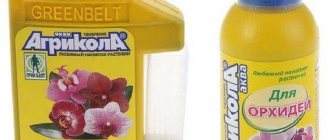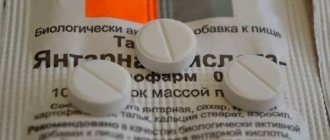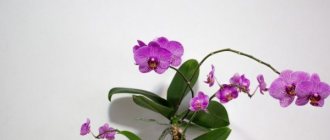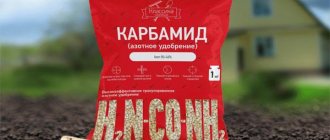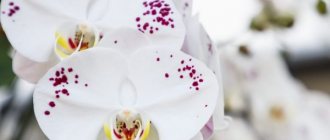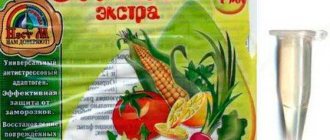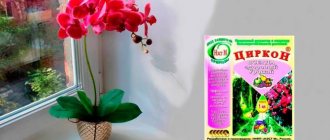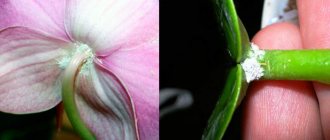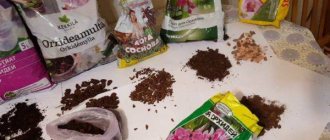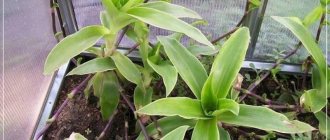The application of mineral fertilizers during the flowering period of the orchid should be done carefully . In this case, a special type of fertilizer is used, which will help prolong flowering.
If you make a mistake with the choice of fertilizing, then in the end you may not improve the condition of the plant, but aggravate its problems.
There are different types of fertilizing, with the help of some the green part of the plant grows, while others help to organize long and beautiful flowering . Let's find out what kind of fertilizer exists for orchid blooms.
Monopotassium phosphate for orchids
From a chemical point of view, potassium monophosphate is a potassium salt of orthophosphoric acid - KH 2 PO 4. As a fertilizer, it is used to provide plants with macroelements - potassium and phosphorus.
Potassium monophosphate is a widely known fertilizer for flowering indoor and garden plants.
Reviews
- Valentina Alexandrovna (Samara).
Previously, potassium monophosphate was used for tomatoes. One day I decided to feed an orchid that had not bloomed for a long time. I was pleasantly surprised when a flower arrow appeared. Since then I have been watering orchids before and during flowering.
- Ekaterina Konstantinovna (St. Petersburg).
Through trial and error, I came to the conclusion that it is better to use potassium monophosphate on its own and not mix it with other fertilizers. Then you won’t have to doubt whether they are compatible or not.
Fertilizer composition and effect on indoor plants
Monopotassium phosphate includes:
| Potassium | 30% |
| Phosphorus | 50 – 55% |
Thanks to phosphorus, the following vital processes occur in all plants, including orchids:
- The regrowth of young and strengthening of adult roots improves;
- The synthesis of chlorophyll, cellulose, starches and other substances that are responsible for full growth and flowering is activated;
- Pigments characteristic of the variety are intensively produced. With enough phosphorus, the flowers grow large and bright.
The main role of potassium is to strengthen the cell membrane. Due to this, a sufficient amount of moisture is retained in the tissues, which ensures full turgor (elasticity) of leaves and flowers. The water supplied during irrigation is fully absorbed by the plant and is well retained in the cells. Therefore, the frequency of irrigation can be reduced.
In addition, potassium is called a plant protector . By forming a dense cell membrane, the element helps strengthen all organs, they become impenetrable to pathogens and are much less damaged by pests.
Thus, potassium monophosphate is not only a supplement, but also a means of protection against adverse effects. Its use gives the following results:
- Fertilizer added to the substrate activates root formation and survival of orchids.
- Application during budding promotes the formation of large flowers.
- Improves the size and quality of blooming buds, and prolongs flowering time.
- Has a preventive and protective effect against diseases and pests.
- Helps orchids tolerate unfavorable conditions - lack of watering, temperature changes and other discomfort.
Eating in a natural environment
Most orchids are epiphytes. This means that they live in trees and their roots cling to branches and hang in the air. They get food from rotten leaves, bird droppings or dust washed away by rain.
These flowers grow well without feeding. Photo used as illustration. Source: Yandex.Images
In other words, minerals arrive very quickly and in small quantities. To survive, Orchids learn to live and bloom in conditions of limited nutrition. Lithophytic Orchids (living on rocks) are also deprived of nutrition, and very effectively use the crumbs that come with rainwater.
On the other hand, there are terrestrial Orchids that live in mineral-rich soil. As a result, they absorb more nutrients. Therefore, more fertilizers should be used for them than for epiphytic plants.
Release form
Monopotassium phosphate is available as a white powder or light brown granules.
Different manufacturers package it in bags or plastic containers.
Since the fertilizer is designed to feed garden plants, it is produced in large volumes. Minimum weight – 0.5 kg.
Monopotassium phosphate is produced in two forms, as white powder or small irregular granules.
Preparing for work
If powder is used to feed orchids, it should not be dissolved in hard water. Rainwater, filtered, without chlorine is best. If you don’t have one, you can use boiled and cooled.
Unlike powder, granules dissolve in water of any hardness without negative consequences for orchids.
The working solution is prepared immediately before use. Due to their high activity, substances quickly disintegrate and evaporate.
Tip #1 . Note! In dry form, the fertilizer can be stored without expiration date.
For indoor plants, it is better to buy packaging that closes tightly after the required amount of powder has been taken from it.
What types of mixtures are there?
There are three types of fertilizers:
- sticks;
- concentrated;
- liquid.
Concentrated
Among concentrated fertilizers, the best are:
- "Rainbow";
- "Ideal";
- "Garden of Miracles";
- "Oasis".
Concentrated products can be used to apply both root and foliar feeding (spraying).
In sticks
Fertilizer sticks are available in a convenient form and contain a maximum of nutrients. Some of them are visually similar to capsules. But, they are not suitable for orchids due to the characteristics of the root system.
The roots are simply not able to pull nutrients from the soil. They are very powerful and often extend beyond the pot. The stick remains in one place, in contact with only a few roots and often leaves burns in these places.
Liquid
Liquid fertilizers are most convenient to use. They contain ready-made substances; all you need to do is dissolve the composition in water. How to prepare the solution is indicated in the instructions on the package. It is much easier for plants to absorb vitamins from the soil if the fertilizer is liquid.
Methods and frequency of use
Potassium monophosphate is used for root feeding and leaf spraying.
If fertilizer is added to the substrate (soil) for orchids, prepare a working solution based on:
- 1 g per 1 liter of water.
This feeding replaces regular watering.
Feeding is applied following the following recommendations:
- The orchid is fed for the first time as soon as it comes out of dormancy and a peduncle with buds appears.
- A repeat session is carried out at the beginning of the buds blooming.
- Another nutrient watering is planned at the height of flowering.
Potassium monophosphate should not be used when the plant is dormant or has been infected with fungal or bacterial diseases. Because pathogenic microorganisms are activated in the presence of phosphorus and potassium. The elements contribute to the rapid development and growth of pathogens.
It is better to use fertilizer as a preventive protective agent . For this purpose, fertilizing is used for foliar spraying .
For this purpose, prepare a solution whose concentration is 3 times less than for root watering.
This means that 1 g of fertilizer must be diluted in three liters of water. To apply the solution to the leaves, use a sprayer with a fine nozzle. The liquid flow rate is determined until a stable cover is formed on the plates. The fertilizer should not be allowed to collect in large drops and flow down. In this case, processing will be ineffective. Moreover, the active substance evaporates quickly, so it is important to retain it using uniform spraying.
The first feeding is carried out after the orchid has completely taken root.
Preventive feeding begins after transplantation, when complete rooting has occurred. The fact that the orchid has taken root can be determined by the growth of two or three new leaves. Then, for the first time, spraying is carried out to strengthen the tissues of young plants.
Repeated treatment will be needed in about a month. Do not apply fertilizer too often. An excess of nutrients negatively affects the general condition of plants. For example, the color of leaves is disturbed and rapid aging occurs. Instead of prolonged flowering, the opposite effect is obtained.
Elements necessary for successful color formation
Which fertilizer is best for orchids? In order for a plant to grow a flower arrow, it must receive the necessary elements in the form of :
All of them are involved in the growth of the peduncle and their percentage content in mineral supplements is usually indicated on the packaging . In all fertilizers intended for orchids, these elements are collected in the required proportions, where nitrogen has a smaller share, which is reduced by almost half:
- Nitrogen is an essential element, important for the formation of leaf blades and their proper growth. Since normally developed leaves are the key to good nutrition of the bush. Its deficiency can be determined by small, unformed leaf blades;
- Phosphorus is the factor that influences the formation of the peduncle itself and without its participation it will not appear at all. It also affects the number of buds and the duration of flowering itself. The lack of an element can be seen in the appearance of the bush. He is depressed and practically does not grow;
- Potassium is responsible for proper and complete metabolism at the cellular level of the orchid. Develops immunity in the plant to various diseases that are inherent in this type of plant. If the buds bloom poorly and have a small diameter, then this is a lack of potassium.
Before purchasing fertilizer, pay attention to the expiration date.
When choosing fertilizers for Phalaenopsis, you need to pay attention to :
- For marking;
- Who is this mineral supplement intended for?
- For expiration date;
- And on the percentage composition of these three main elements.
Read also: Cucumber with a long fruiting period
So for spring fertilization, the nitrogen part should predominate or be at least on par with the other two main components. In the fall, when preparations are underway for flowering, fertilizer with a large amount of phosphorus is selected.
Nitrogen fertilizers
Common nitrogen fertilizers for orchids:
- Substral Orchid Food for orchids;
- Bioekor for orchids.
As can be seen from the characteristics, nitrogen predominates in these fertilizers and is used in the spring during the vegetative growth of the plant.
When should it be applied and in what proportions?
Nitrogen fertilizers are applied at the moment when the flower’s dormant period ends and it begins to grow its foliage. This usually begins with the beginning of spring, since at this time, with an increase in heat and light, dormant buds wake up and sap flow begins.
Feeding scheme
Nitrogen fertilizers are applied twice a month, and they are diluted as indicated on the package, without increasing the dosage. Since this can lead to the death of the plant.
Potassium-phosphorus fertilizers
Popular potassium-phosphorus fertilizers for orchids:
- Uniflor-bud;
- Fertika (kemira) for flowering plants.
Phosphorus-based fertilizers for orchids are often used.
Fertilizer Flower Happiness is also popular; many customers leave reviews.
Methods of depositing and deadlines
Such fertilizers begin to be applied with the arrival of autumn. There are two methods of fertilizing:
In the first case, the diluted fertilizer is poured into a suitable container and the orchid is placed there for a period of 20 minutes. In this case, from time to time it is necessary to shed the soil from above while this time passes. This is done so that the soil (bark) gets wet evenly . Then the flower is taken out of the container with fertilizer and the water is allowed to drain completely, tilting the container with the plant at an angle of 45 degrees.
In the second case, the foliage is sprayed , and water is removed from the axils of the Orchid so that the trunk does not begin to rot.
Monitor the amount of moisture applied to the leaf surface and remove excess to avoid rotting spots.
Scheme
Fertilizers are diluted according to the instructions printed on the package, without increasing the dosage, as this can lead to the death of the orchid bush. Fertilize the orchid with phosphorus-potassium fertilizers every 10 days.
Risks of overdose
It is better to underfeed an orchid than to overfeed it. When overdosed with fertilizers, its foliage shrinks, after which it turns yellow and disappears.
It is better to underfeed orchids than to overfeed them.
In this case, it is necessary to immediately begin resuscitation of the plant, since it will not help itself.
Can it be used during flowering?
How to fertilize an orchid during flowering? You can fertilize your orchid with a large amount of potassium and phosphorus - this will help extend the flowering period and the formation of buds.
If such preparations are applied regularly, the flowers will have a more saturated hue and open fully, gaining diameter according to their specific description.
Therefore, you should pay attention to liquid fertilizers that will help extend the period of budding and flowering . Fertilizer must be carefully applied during flowering.
How to use?
Such preparations are administered with the beginning of the growth of the flower arrow and continue to be used throughout the period of bud formation. Fertilizers for flowering are applied at a rhythm of 2 times a week. This is especially important if there are 2-3 peduncles on the bush. In order for the plant to have enough strength, it needs help in building up the flower mass.
Consequences
When the buds are completely dissolved, you need to stop feeding the flower , as this can lead to premature aging of the flowers and they will begin to wrinkle and wither. At the same time, getting liquid on the flowers can ruin their appearance. Light brown spots will appear on the petals.
Precautionary measures
Potassium monophosphate cannot be considered a harmless substance. Working with it requires the use of personal protective equipment (PPE). The following must be protected from volatile substances:
- Eyes , tight-fitting plastic glasses;
- Respiratory organs using a mask;
- Hands with rubber gloves.
PPE will be needed to prepare the working solution and during the main feeding. During the work, it is necessary to remove unauthorized persons who are not protected by equipment. This is especially true for children.
If the liquid accidentally gets on the skin, rinse with plenty of warm water.
